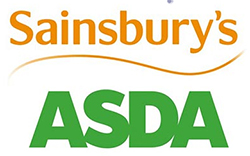The latest United Kingdom grocery market share figures, published by Kantar Worldpanel for the 12 weeks through April 22, 2018, reveal a market share of 15.9% and 15.5% for Sainsbury’s and Asda, respectively, giving the proposed combined entity a potential share of 31.4%.
During the period, Sainsbury’s increased sales by 0.2% while Asda’s receipts rose by 1.4%. Both Sainsbury’s and Asda dropped market share compared to the like period a year ago – down 0.3 percentage points and 0.1 percentage points, respectively.
 Keen on the proposed merger to create Britain’s biggest grocery, general merchandising and clothing retail group are (left to right) Sainsbury’s CEO Mike Coupe, Walmart International President and CEO Judith McKenna, and Asda CEO Roger Burnley.Late last month Sainsbury’s confirmed that mega-merger talks with Asda, a subsidiary of Walmart, are at an “advanced stage.” The combination would result in Walmart holding 42% of the issued share capital of the overall business and receiving £2.975 billion of cash (subject to customary completion adjustments), valuing Asda at approximately £7.3 billion on a debt-free, cash-free and pension-free basis.
Keen on the proposed merger to create Britain’s biggest grocery, general merchandising and clothing retail group are (left to right) Sainsbury’s CEO Mike Coupe, Walmart International President and CEO Judith McKenna, and Asda CEO Roger Burnley.Late last month Sainsbury’s confirmed that mega-merger talks with Asda, a subsidiary of Walmart, are at an “advanced stage.” The combination would result in Walmart holding 42% of the issued share capital of the overall business and receiving £2.975 billion of cash (subject to customary completion adjustments), valuing Asda at approximately £7.3 billion on a debt-free, cash-free and pension-free basis.
Should the deal be approved by the UK’s Competition and Markets Authority (CMA) and consummated, the combined group would operate 2,800 stores and claim a larger market than current leader Tesco’s 27.6% share.
“This is a pivotal moment for the British grocery market. A merger between Sainsbury’s and Asda would transform the traditional landscape, placing nearly a third of market share in the hands of the joint supermarket giant, though the march of the discounters – and any enforced store closures – could impact this figure,” commented Fraser McKevitt, head of retail and consumer insight at Kantar Worldpanel.
“The two supermarkets appeal to different customer bases,” he added. “Asda achieves nearly two-thirds of its sales outside London and the southeast of England in contrast to Sainsbury’s, which registers 59% of its sales in those two areas. Sainsbury’s also appeals to more affluent shoppers. This demographic accounted for 62% of all sales at Sainsbury’s in comparison to 46% of sales at Asda. Meanwhile, Sainsbury’s premium own-label line ‘Taste the Difference’ clocked up sales of £832 million annually – nearly two and a half times the size of Asda’s ‘Extra Special’ range.”
Outselling Sainsbury’s in branded goods, Asda also attracts a greater number of households through its doors.
McKevitt continued: “15.8 million households bought their groceries at Asda over the past 12 weeks –500,000 more households than shopped at Sainsbury’s – but we are seeing a substantial number of customers frequenting both retailers. Nearly nine million households visited both Sainsbury’s and Asda, with consumers showing little retailer loyalty.”
Overall, the British grocery market grew at its slowest rate since March 2017 at 2.0%, which was the result of lower grocery price rises. The like-for-like inflation rate is now 2.1% and is expected to fall further in the coming months.
“Tesco and Morrisons both performed strongly this period,” said McKevitt. “Morrisons was crowned the fastest-growing traditional supermarket, raking in sales growth of 2.2% and holding market share at 10.5%. Although Morrisons continues to prove a favorite with shoppers in its northern heartlands, the retailer is also excelling in the capital, where it is growing at its fastest rate. Meanwhile, for the twelfth consecutive period, Tesco has grown more than 2.0% – the first time the retailer has achieved this since March 2011.”
Lidl Leads in Store Growth
 With sales up 9.1%, Lidl became the UK’s fastest-growing bricks and mortar supermarket. The discounter upped its market share by 0.4 percentage points compared to this time last year to reach 5.4%. Despite traditionally performing well in sales of private label products, branded sales at the retailer rocketed by 32% with sales of branded alcohol, soft drinks and dairy proving particularly successful.
With sales up 9.1%, Lidl became the UK’s fastest-growing bricks and mortar supermarket. The discounter upped its market share by 0.4 percentage points compared to this time last year to reach 5.4%. Despite traditionally performing well in sales of private label products, branded sales at the retailer rocketed by 32% with sales of branded alcohol, soft drinks and dairy proving particularly successful.
Meanwhile, Aldi has continued to experience strong sales growth at +7.7%, increasing its market share by 0.4 percentage points to 7.3%.
Sales at both Iceland and Waitrose rose by 0.2%. Frozen food specialty retailer Iceland continues to hold market share at 2.1%, while Waitrose dropped share by 0.1 percentage points on last year to 5.1%.
With the disposal of 300 McColl’s stores still impacting headline performance, Co-op saw sales fall by 0.4% as its market share fell by 0.1 percentage points to 6.0%. Ocado’s sales jumped by 12.7%, helping the e-commerce retailer to increase market share by 0.1 percentage points to 1.2%.





